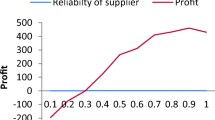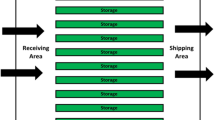Abstract
In this study, we consider coordinated scheduling of the transfer lots in an assembly-type supply chain. An assembly-type supply chain consists of at least two stages, where the upstream stages manufacture the components for several products to be assembled at the downstream stages. In order to enable faster flow of products through the supply chain and to decrease the work-in-process inventory, the concept of lot streaming is used as a means of supply chain coordination. We introduce a mathematical model, which finds the optimal transfer lot sizes in the supply chain. The objective is the minimization of the sum of weighted flow and inventory costs. We develop genetic algorithm (GA) based heuristics to solve the proposed model efficiently. The experimental results show that the proposed GA-based approaches provide acceptable results in reasonable amount of time. We also show that coordination with lot streaming provides improvements in the supply chain performance.







Similar content being viewed by others
References
Arshinder, K., Kanda, A., & Deshmukh, S. G. (2008). Supply chain coordination: Perspectives, empirical studies and research directions. International Journal of Production Economics, 115, 316–335.
Behnamian, J., & Fatemi Ghomi, S. M. T. (2012). Incorporating transportation times in multi-agent production network scheduling. International Journal of Computer Integrated Manufacturing, 25(12), 1111–1128.
Behnamian, J., & Fatemi Ghomi, S. M. T. (2014). A survey of multi-factory scheduling. Journal of Intelligent Manufacturing. doi:10.1007/s10845-014-0890-y.
Chan, H. K., & Chan, F. T. S. (2010). A review of coordination studies in the context of supply chain dynamics. International Journal of Production Research, 48(10), 2793–2819.
Chan, F. T. S., Wong, T. C., & Chan, L. Y. (2008). Lot streaming for product assembly in job shop environment. Robotics and Computer-Integrated Manufacturing, 24, 321–331.
Chang, J. H., & Chiu, H. N. (2005). A comprehensive review of lot streaming. International Journal of Production Research, 43(8), 1515–1536.
Chen, Z., & Pundoor, G. (2006). Order Assignment and Scheduling in a Supply Chain. Operations Research, 54(3), 555–572.
Chen, Z., & Hall, N. G. (2007). Supply chain scheduling: Conflict and cooperation in assembly systems. Operations Research, 55(6), 1072–1089.
Cheng, M., Mukherjee, N. J., & Sarin, S. C. (2013). A review of lot streaming. International Journal of Production Research, 51(23–24), 7023–7046.
Choi, T. M., Yeung, W. K., & Cheng, T. C. E. (2013). Scheduling and co-ordination of multi-suppliers single warehouse-operator single-manufacturer supply chains with variable production rates and storage costs. International Journal of Production Research, 51(9), 2593–2601.
Dawande, M., Geismar, H. N., Hall, N. G., & Sriskandarajah, C. (2006). Supply chain scheduling: Distribution systems. Production and Operations Management, 15(2), 243–261.
Gen, M., & Cheng, R. (2000). Genetic algorithms and engineering optimization. New York: Wiley.
Goldberg, D. E. (1989). Genetic algorithms in search, optimization and machine learning. USA: Addison Wesley Longman Inc.
Hall, N. G., & Potts, C. N. (2003). Supply chain scheduling: Batching and delivery. Operations Research, 51, 566–584.
Hong, K., Yeo, S. S., Kim, H. J., Chew, E. P., & Lee, C. (2012). Integrated inventory and transportation decision for ubiquitous supply chain management. Journal of Intelligent Manufacturing, 23, 977–988.
Kalir, A. A., & Sarin, S. C. (2000). Evaluation of the potential benefits of lot streaming in flow-shop systems. International Journal of Production Economics, 66(2), 131–142.
Kirkpatrick, S. (1984). Optimization by simulated annealing: Quantitative studies. Journal of Statistical Physics, 34(5–6), 975–986.
Kim, K., & Jeong, I. J. (2009). Flow-shop scheduling with no-wait flexible lot streaming using an adaptive genetic algorithm. International Journal of Advanced Manufacturing Technology, 44, 1181–1190.
Kim, S., & Ha, D. (2003). A JIT lot-splitting model for supply chain management: Enhancing buyer-supplier linkage. International Journal of Production Economics, 86(10), 1–10.
Ko, M., Tiwari, A., & Mehnen, J. (2010). A review of soft computing applications in supply chain management. Applied Soft Computing, 10(3), 661–674.
Kumar, S., Bagchi, T. P., & Sriskandarajah, C. (2000). Lot streaming and scheduling heuristics for \(m\)-machine no-wait flowshops. Computers & Industrial Engineering, 38, 149–172.
Lehoux, N., D’Amours, S., & Langevin, A. (2014). Inter-firm collaborations and supply chain coordination: Review of key elements and case study. Production Planning & Control, 25(10), 858–872.
Li, C., & Xiao, W. (2004). Lot steaming with supplier-manufacturer coordination. Naval Research Logistics, 51, 522–542.
Lim, T. Y. (2014). Structured population genetic algorithms: A literature survey. Artificial Intelligence Review, 41, 385–399.
Maloni, M. J., & Benton, W. C. (1997). Supply chain partnerships: Opportunities for operations research. European Journal of Operational Research, 101, 419–429.
Manoj, U. V., Gupta, J. N. D., Gupta, S. K., & Sriskandarajah, C. (2008). Supply chain scheduling: Just-in-time environment. Annals of Operations Research, 161(1), 53–86.
Min, H., Ko, C. S., & Ko, H. J. (2006). The spatial and temporal consolidation of returned products in a closed-loop supply chain network. Computers & Industrial Engineering, 51(2), 309–320.
Pasandideh, S. H. R., Niaki, S. T. A., & Mirhosseyni, S. S. (2010). A parameter-tuned genetic algorithm to solve multi-product economic production quantity model with defective items, rework, and constrained space. The International Journal of Advanced Manufacturing Technology, 49(5–8), 827–837.
Potts, C. N., Sevast’janov, S. V., Strusevich, V. A., Van Wassenhove, L. N., & Zwaneveld, C. M. (1995). The two-stage assembly scheduling problem: Complexity and approximation. Operations Research, 43, 346–355.
Sarin, S. C., Yao, L., & Trietsch, D. (2011). Single-batch lot streaming in a two-stage assembly system. International Journal of Planning and Scheduling, 1(1/2), 90–108.
Sawik, T. (2009). Coordinated supply chain scheduling. International Journal of Production Economics, 120(2), 437–451.
Thomas, D. J., & Griffin, P. M. (1996). Coordinated supply chain management. European Journal of Operational Research, 94, 1–15.
Ventura, J. A., & Yoon, S. (2013). A new genetic algorithm for lot-streaming flow shop scheduling with limited capacity buffers. Journal of Intelligent Manufacturing, 24, 1185–1196.
Wong, T. C., Chan, F. T. S., & Chan, L. Y. (2009). A resource-constrained assembly job shop scheduling problem with lot streaming technique. Computers & Industrial Engineering, 57, 983–995.
Yao, L., & Sarin, S. C. (2014). Multiple-lot lot streaming in a two-stage assembly system. In P. S. Pulat, S. C. Sarin, & R. Uzsoy (Eds.), Essays in production, project planning and scheduling, International Series in Operations Research & Management Science 200 (pp. 357–388). New York: Springer.
Yeung, W. K., Choi, T. M., & Cheng, T. C. E. (2010). Optimal scheduling of a single supplier single-manufacturer supply chain with common due windows. IEEE Transactions on Automatic Control, 55(12), 2767–2777.
Yeung, W. K., Choi, T. M., & Cheng, T. C. E. (2011). Supply chain scheduling and coordination with dual delivery modes and inventory storage cost. International Journal of Production Economics, 132, 223–229.
Yoon, S., & Ventura, J. A. (2001). An application of genetic algorithms to lot-streaming flow shop scheduling. IIE Transactions, 34, 779–787.
Yokota, T., Gen, M., & Li, Y. (1996). Genetic algorithm for non-linear mixed integer programming problems and its applications. Computers & Industrial Engineering, 30(4), 905–917.
Author information
Authors and Affiliations
Corresponding author
Appendix
Appendix
-
a.
The weighted flow time cost: The products are delivered to the customers in transfer lots, and the portion of the demand delivered in each sublot is important. For this reason, the flow time cost is weighted by the portion of the demand delivered to the customer in Eq. (15).
$$\begin{aligned} A=\sum _{k} {\alpha _{k}\sum _{l=1}^{n_{k}} {\left( {{X_{0,1,kl}}/{D_{k}}}\right) W_{0,1,kl}}} \end{aligned}$$(15) -
b.
The inventory cost: We consider two types of inventory costs.
WIP inventory cost of components For the manufacturer, an example trajectory of a component’s WIP inventory is presented in Fig. 8. The total inventory costs for all the components are provided in Eq. (16). The first term of Eq. (16) denotes the waiting time of the components after receiving the sublot from supplier till starting to process it in the manufacturer. Note that \(M_{1,j,k,l}\) denotes the inventory level of the component needed to manufacture product \(k\) after the receipt of \(l\hbox {th}\) sublot from \(j\hbox {th}\) supplier. The second term of Eq. (16) is the WIP inventory of the component when the \(l\hbox {th}\) sublot of product \(k\) starts processing. Raw material inventory for the suppliers is not considered in the objective function.
Inventory cost of finished goods For a supplier, an example trajectory of the finished good’s inventory is presented in Fig. 8. In Eq. (17) the first term denotes the inventory cost during the process of the sublot. The second term shows the inventory cost between sublot completion and delivery. We consider the inventory of finished goods for the suppliers and the manufacturer.
Rights and permissions
About this article
Cite this article
İnkaya, T., Akansel, M. Coordinated scheduling of the transfer lots in an assembly-type supply chain: a genetic algorithm approach. J Intell Manuf 28, 1005–1015 (2017). https://doi.org/10.1007/s10845-015-1041-9
Received:
Accepted:
Published:
Issue Date:
DOI: https://doi.org/10.1007/s10845-015-1041-9





